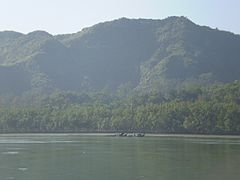Arakan Mountains
| Arakan Mountains | |
|---|---|
| Rakhine Mountains | |
 View of the Arakan Mountains inMaungdaw districtrising above the banks of theNaf River | |
| Highest point | |
| Peak | Mount Victoria |
| Elevation | 3,094 m (10,151 ft) |
| Coordinates | 21°25′46.36″N93°49′10.75″E/ 21.4295444°N 93.8196528°E |
| Naming | |
| Native name | ရခိုင်ရိုးမ(Burmese) |
| Geography | |
| Country | Myanmar |
| State | Rakhine State |
| Range coordinates | 21°16′N93°57′E/ 21.267°N 93.950°E |
| Geology | |
| Type of rock | metamorphic and tightly folded sedimentary rocks over crystalline basement |
TheArakan Mountains,natively referred asRakhine Yoma(Burmese:ရခိုင်ရိုးမ) and technically known as theSouthern Indo-Burman Range,are amountain rangein westernMyanmar,between the coast ofRakhine Stateand the Central Myanmar Basin, in which flows theIrrawaddy River.It is the most prominent of a series of parallel ridges that arc throughAssam,Nagaland,Manipur,Mizoramand Myanmar.
The Arakan Mountains run fromCape Negraisin the south in toManipur,India in the north. They include theNaga Hills,theChin Hills,and thePatkai rangewhich includes theLushai Hills.[1]The mountain chain is submerged in theBay of Bengalfor a long stretch and emerges again in the form of theAndaman and Nicobar Islands.
Etymology
[edit]The wordArakanis derived from theSanskritwordRakshasa(राक्षस), a term used to refer to the inhabitants of the region.[2]
Geology and formation
[edit]The Arakan Mountains and the parallel arcs to the west and east were formed by compression as theIndian Platecollided with theEurasian Plateapproximately along the boundary between India and Myanmar which produced the Naga-Patkai foldbelt.[3][4]
High points
[edit]The Arakan Mountain Range is over 600 miles (950 km) long,[1]with about 250 miles (400 km) of actual mountains. The highest point in the range isKhonu Msung(or Mount Victoria) at 3,094 metres (10,151 ft).[citation needed]
Infrastructure
[edit]The Arakan Mountains are crossed by a road betweenNgapeandMinbuand by an all-weather road from Taungup toPyayon the Irrawaddy.[citation needed]
History
[edit]The Arakan Mountains divide the Rakhine coast from the rest of Myanmar, and thus have acted as a barrier between the peoples of central Myanmar and those of the Indian subcontinent. This played a role in fostering the separate development of theRakhine people,both linguistically and culturally, from theBurmese.The Arakan Mountains also served as a barrier inhibiting Burmese invasions, and allowing Arakan to develop as a separate political entity. Thus the coastal cities, such asMrauk UandWaithali,formed the core of Arakan civilization.[citation needed]
There were fierce battles in these mountains between January 1943 and March 1944 during theJapanese occupation of Burma.The Japanese 33rd and 55th Divisions faced the British military on the coastal side of the range. The British forces won.[citation needed]
Ecology
[edit]The Arakan Mountains act as a barrier to the southwestern monsoon rains and thus shield the central Myanmar area, making their western slopes extraordinarily wet during the monsoon with typically over 1 metre (39 in) of rain per month, and the eastern slopes much drier.[1]They include theChin Hills-Arakan Yoma montane forests ecoregionwhich is home to anelephantpopulation and also the critically endangeredArakan forest turtlewhich was considered extinct until its rediscovery in 1994.[5]
Notes
[edit]- ^abc"Rakhine Mountains".Encyclopædia Britannica.Retrieved9 Nov2013.
- ^The Indian Magazine and Review, Issues 265-276.National Indian Association in Aid of Social Progress and Education in India. 1893. p. 403.
- ^SeeGeology of India#Plate tectonicsfor more detail.
- ^Akhtar, Mohammad S.et al.(2010)"Structural Style and Deformation History of Assam & Assam Arakan Basin, India: from Integrated Seismic Study"(adapted from oral presentation at AAPG Annual Convention, Denver, Colorado, June 7–10, 2009)
- ^Platt, K.;Rahman, S.; Horne, B.D.; Praschag, P. (2020)."Heosemys depressa".IUCN Red List of Threatened Species.2020:e.T39596A2929864.doi:10.2305/IUCN.UK.2020-2.RLTS.T39596A2929864.en.Retrieved26 October2022.Listed as Critically Endangered (CR A2cd+4cd v3.1)

